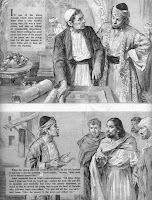 Some of you may remember me asking about 3 weeks ago,
Some of you may remember me asking about 3 weeks ago,"if anyone has any back issues of 'The Bible Story' I'd be very interested", Well, it just so happens that Gill Donaldson from Edinburgh had been clearing out her mothers attic, and came across a complete set of them still in the red and gold binder from when she was a child.
Gill then went onto the internet to search for more information about the magazine, and came across my 'Look & Learn' post!
To cut a long story short, she very kindly allowed me to purchase them, and they are now in my possession!
The collection is in the original binder holding the complete set of 29 issues in mint condition from 1964! And they are superb! The binders were only made to hold 26 issues so the last 3 are loose.
In issue 29, on page 11 there's a full page ad which announces:
"The Editors of The Bible Story announce that as from next week's issue The Bible Story will be incorporated in Look & Learn"
So, issues of 'Look & Learn' dated around 26th September 1964 onwards would have included the continuation of 'The Bible Story' series. Does anyone know how many combined issues followed? If anyone has some of these combined issues, I'd be very interested! (It worked the first time!) :0)
Presumably, the publishers were not selling as many copies of 'The Bible Story' as they had hoped to, and therefore decided to incorporate it into 'Look and Learn'. This would also explain the 3 loose copies!
Thanks to the index that Gill enclosed, (which names almost every artist in the collection), I can now put a name to just about every Bible Artist that I know of! It seems like almost every children's Bible for the last 30 years has included some artwork that appeared in 'The Bible Story' collection!
There are two artists in-particular that stand out. One is Jack Hayes, and the other, Paul Rainer. (Rainer seemed to work in black & white pastel). Above is a sample of Rainer's work. (Image © 'Look & Learn' Magazine Ltd).
Other good artists who contributed include:
James E McConnell (Who did many of the covers).
Don Lawrence
Fortunino Matania
John Millar Watt
Henry Seabright
Selby Donnison, and many more! Sadly, some of the excellent artwork listed in the index remains anonymous.
My only criticism of 'The Bible Story' magazine was the print quality. When you compare the Jack Hayes cover art #22 'The Death of John the Baptist' with the scan of the original artwork displayed on the Look & Learn website, there is really no comparison. Other than that, this collection is still a 'must have' for any Bible artist. It's not just the artwork that is excellent, There are weekly articles on animals of the Bible, everyday life in Bible times, who's who in the Bible etc, etc. It really is packed with info!
A big thanks to Gill Donaldson, and to her son who so carefully parceled the book!
Posts on other helpful books:
The Great Bible Discovery series
Finding Harold Copping
The World Jesus knew
The Splendor of the Temple

